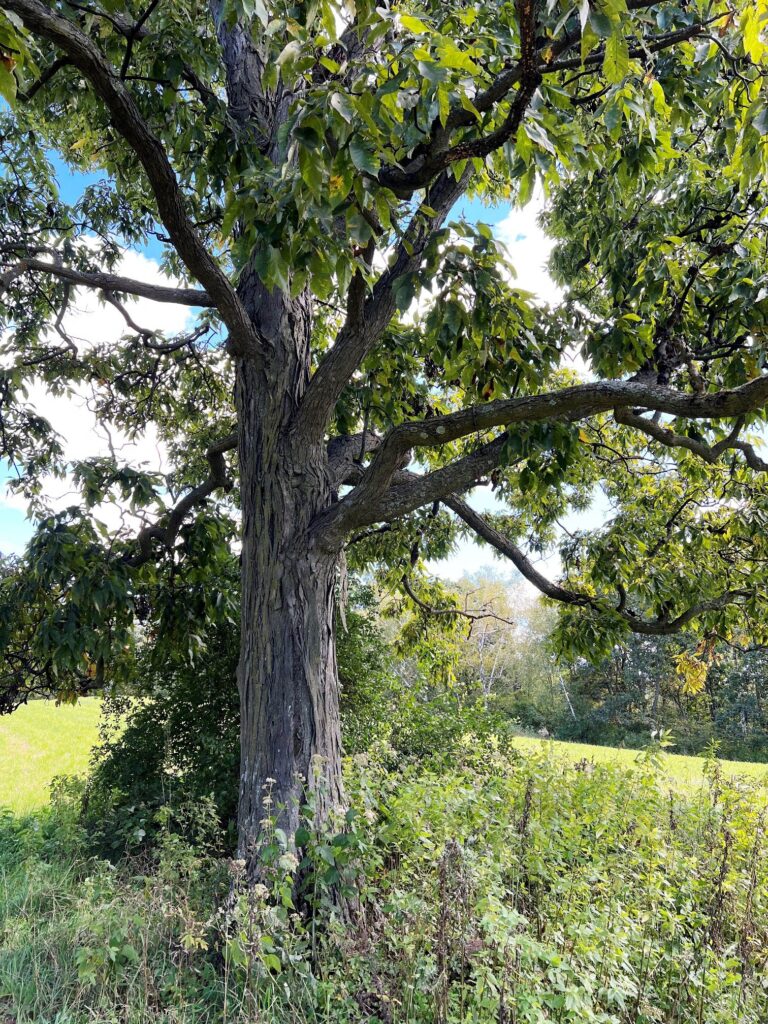Back Home by Chris Hardie
- Download this column as a Word document
- Download the photos that accompany this story
- Chris Hardie’s headshot

In the middle of one of my ridgetop clearings stands a large shagbark hickory tree that’s nearly 100 feet tall.
Those in the know are no longer with us, but I believe the tree was left there for a purpose. It was likely the anchor tree used when the land was cleared nearly 100 years ago.
Some conjure images of acres and acres of flat and fertile prairie fields when they think of farming, but that was not the case for much of the Driftless Region of Wisconsin. Our numerous ridges and valleys meant that settlers wanting to farm had to create much of their tillable land.
Many of the 50 acres or so of the ridgetop fields on our farm were created without the benefit of a tractor. Using horses and a grubber, the stumps were pulled out and placed on a stone boat to be pulled away. It was hard and slow work.
The basic principle of the stump puller was two horses hitched to the end of the sweep log or beam. They were driven in a circle to turn the cable drum on the stump puller — which was anchored to another stump or a tree.
The drum cable was attached to the stump and became tighter and tighter. The tremendous force applied at a very slow rate eventually pulled up the stump. Softwood trees pulled out much easier compared to oak trees, which had a deeper tap root.
Several years ago I came across the remnants of the 1906 stump puller used by my ancestors. But a key part of the stump-pulling operation was to have an adequate anchor tree. There are still a few of those trees standing in the middle of fields – like our hickory.
The average lifespan of a shagbark hickory is 200 years. Our hickory has been as massive and impressive as today for the 50-plus years that I can remember.
Shagbarks are easy trees to identify, with their gray, ridged and rough bark that curls outward to give them their shaggy appearance. The trees reach maturity and start producing seeds when they reach 40 years old.
Recently my wife Sherry and I checked the tree for nuts. This was a light year of production for the big tree, but we found a bumper crop on some nearby trees at the edge of the clearing which probably grew from squirrels burying nuts from the large tree.
It was a gorgeous fall afternoon as Sherry and I gathered up the nuts that had fallen to the ground. Hickory nuts still on the tree are not yet ripe. We collected nearly 2/3rds of a grocery bag.
Hickory nuts are double-shelled, with a green outer husk that dries to a brown color as the nuts ripen. The husk splits after ripening, revealing the hard and woody nutshell inside.
The real work after the husks dry down will be later when we try to break open the nutshell to get to the treasure inside – a flavor similar to pecans or mild walnuts that can be used for baking like any other calorie-dense nut.
We will try a nutcracker but I suspect a hammer and stone may be involved. There is a reason hickory nuts are not grown commercially.
But as my late father always said, sometimes the solution is a bigger hammer. I am a bit stubborn, so we’ll see what nut will be the hardest to crack.



